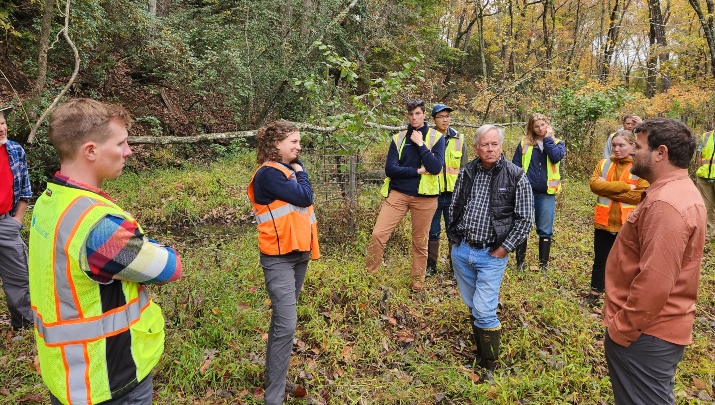

Why We Hired a People and Culture Leader, not a Director of Human Resources
- Keith Bowers
- Biohabitats, Inc
Conventional business wisdom tells you that when your company grows to about 100 employees, it’s time to hire a full-time Human Resources Director. At Biohabitats, we are not quite there, but we began to feel the growing pains of not having someone dedicated full time to HR about two years ago. With eight bioregion offices scattered across the US and work throughout the world, the need to have someone solely dedicated to our team members’ well-being became paramount. As we began thinking about this position, we wanted to be sure it both reflected and reinforced our culture, and we couldn’t come to terms with the label ‘Human Resources Director.’
Traditionally, Human Resources is a management position. It is about making sure you are meeting the legal requirements you need to meet as a company, managing employee benefit programs, supporting your onboarding and offboarding processes, and resolving conflicts. Of course, we need to do all these things, but staying on the right side of legal requirements seemed like a low bar; we thought we could do better.
In our minds, humans aren’t resources, rather they are people striving for fulfilling, healthy, and secure lives within and outside work. For us, ‘People and Culture Leader’ seemed better; it both characterizes the roles and responsibilities of the position, while at the same time reinforcing our culture, identity, and purpose. You can say it’s semantics, and that it’s basically another name for the same position, but I would argue that language matters.
At Biohabitats, we restore ecosystems, conserve habitats, and support the regeneration of the natural systems that sustain life on Earth. We focus on managing projects and processes, not people. As a learning organization whose culture is underpinned by a belief in ecological democracy (the rights of Nature), we take our cues from Nature when it comes to organizational structure and relationships. For us, it’s about enabling our team members to fully express themselves, bringing energy, passion, and creativity to their work.
Our structure is based on three overarching principles: self-management, wholeness, and evolutionary purpose. With self-management, for example, our team members have high autonomy. They are accountable to themselves, their fellow team members, their clients, and to the Earth and all non-human beings. As we conceived of this new position, we wanted to focus foremost on cultivating our culture, nurturing team member aspirations, and fostering wholeness. We needed to be clear about what we value and what we want to achieve as an organization.
Our People and Culture Leader has been in place for a year now. People often ask if we notice a shift since Katherine started. The answer is a resounding yes. At a base level, we have doubled-down to make sure that Biohabitats operates from a Purpose driven, People First perspective by weaving our values, mission, purpose and the needs of our team into our daily practices. As an example, with one dedicated person, we are now better positioned to translate what it means to be a B-Corps and 1% for the Planet member into our daily operations.
Another great example is the creation of our Headwaters document. We recently revamped our policy manual and created, instead, a document focused around the tenets of self-management, wholeness and evolutionary purpose, and grounded in our values. In nature, the headwaters of a watershed is where many ecological processes begin their journey toward estuaries and the ocean. In a nod to this, we named our document Headwaters: A Guide to Biohabitats Benefits, Policies and Cultural Practices. The focus is not rules and regulations, but rather culture and people. In this guide we not only articulate our five Core Values, which include Revere Wild Nature, Heal Compassionately, Practice Wholeness, Act with Uncompromising Integrity, and Evolve to be the Best, but we have carefully organized all our benefits and policies to support these values. Ultimately, Headwaters serves more as an expression of the heights to which we aspire to rise, rather than the minimum depth under which we will not sink.
Further, we’ve been able to take many of the general things we do as part of running a business and lift them to a level that honors our focus on culture. For example, as part of our open book policy, we routinely hold quarterly meetings with the entire team to review our financial performance from the preceding quarter. Now that our People and Culture Leader is leading the effort, it has become so much more than simply a financial performance review. We now weave in our social and environmental impact performance, our DEI work, and other initiatives that directly speak to Biohabitats’ culture and values. In keeping with the theme of a watershed as a metaphor, our quarterly review meeting has been repurposed as our Quarterly Confluence.
In short, having someone in the People and Culture Leader position has given us one, clear person who we know is always keeping an eye on all aspects of our operations through the lens of our culture and our values. We have become more consistent in the way we communicate with each other and in the way we connect with our clients and stakeholders. Our internal culture has always been strong and grounded in deeply shared beliefs, but now we have someone making sure that we are consistent across all our work, our conversations, our locations, and our messaging.
Importantly, we are preparing for a leadership and ownership transition at Biohabitats, as I prepare to step down as CEO in the coming years. Like Patagonia, Biohabitats will be transitioning to a Perpetual Purpose Trust, further reinforcing our commitment to our mission of Restoring the Earth and Inspiring Ecological Stewardship. As we move through this transition, I am relying heavily on our People and Culture Leader to help us think through that process and ensure that our plans and decisions stay true to our mission, values, and purpose.
As to whether or not hiring a People and Culture Leader instead of an HR Director is the right move for your business, you will have to evaluate against your own culture and beliefs. But I believe that any Evergreen® business, with a commitment to leading with Purpose and putting People (and, for us, Planet) First, would be a strong candidate. ‘People and Culture’ and ‘Human Resources’ are not the same thing. Language matters. It’s an important first step in communicating how you think about and value your team and the culture you wish to create and nurture in your business.
More Articles and Videos

Both/And Thinking: Harnessing the Positive Potential of Tensions
- Marianne Lewis
- Carl L. Linder College of Business, University of Cincinnati

Leading Through Uncertainty – Tugboat Institute® Summit 2025
- Jackie Hawkins
- Tugboat Institute

Get Evergreen insight and wisdom delivered to your inbox every week
By signing up, you understand and agree that we will store, process and manage your personal information according to our Privacy Policy




